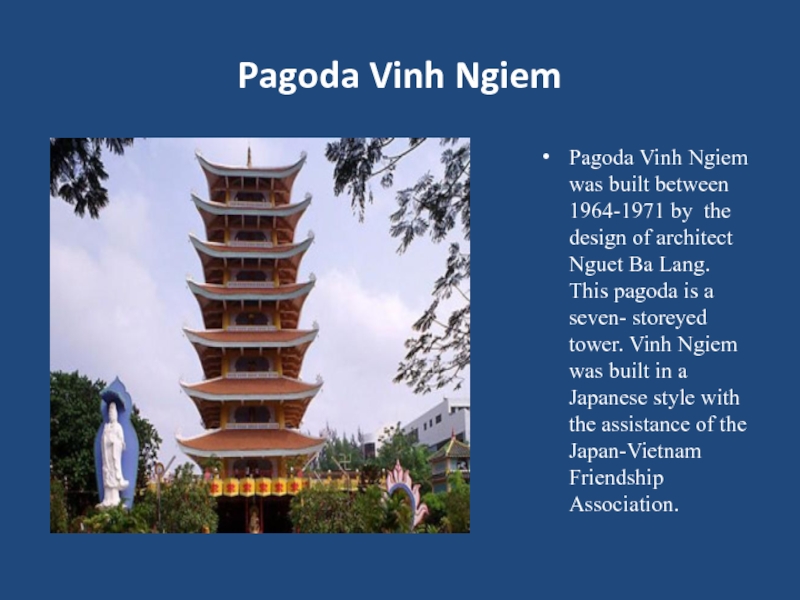Разделы презентаций
- Разное
- Английский язык
- Астрономия
- Алгебра
- Биология
- География
- Геометрия
- Детские презентации
- Информатика
- История
- Литература
- Математика
- Медицина
- Менеджмент
- Музыка
- МХК
- Немецкий язык
- ОБЖ
- Обществознание
- Окружающий мир
- Педагогика
- Русский язык
- Технология
- Физика
- Философия
- Химия
- Шаблоны, картинки для презентаций
- Экология
- Экономика
- Юриспруденция
Let`s meet Vietnam!
Содержание
- 1. Let`s meet Vietnam!
- 2. The map of Vietnam
- 3. Geography and natureVietnam is the state of
- 4. Economy, transport communicationsThe basis of the economy
- 5. HistoryThe first State on the territory of
- 6. The population
- 7. The populationThe population of Vietnam is about
- 8. The climateVietnam has a tropical climate in
- 9. FloraAbout 40% of territory of the country
- 10. Wildlife
- 11. Wildlife of VietnamThe forests of Vietnam are
- 12. Places of interest
- 13. Ho Chi Minh mausoleum
- 14. The Temple of literature, dedicated to Confucius
- 15. The Temple of literature, dedicated to ConfuciusThe
- 16. Pagoda Vinh NgiemPagoda Vinh Ngiem was built
- 17. Pagoda in HanoiThis pagoda was built on
- 18. sourceswww.google.ru/webhp?client=opera&sourceid=opera#newwindow=1&q=the+map+of+vietnamhttps://www.google.ru/webhp?client=opera&sourceid=opera#newwindow=1&q=the+southern+china+seaThe countries of the world encyclopaedic reference-Smolensk: Rusich, 2000.-624s.http://discoveric.ru/mesta/vetnam/hanoj/pagoda-taj images.yandex.ru http://poleznoesoveti.ru/turizm/dostoprimechatelnosti-i-foto-vetnama.html
- 19. Thank you for your attention!
- 20. Скачать презентанцию
The map of Vietnam
Слайды и текст этой презентации
Слайд 4Economy, transport communications
The basis of the economy is agriculture. The
main crop is rice. In large quantities corn, manioc, sorghum,
sweet potato are produced.Important commercial goods are rubber, soybeans, coffee, tea.
The most developed industries are food, textile, oil industry, machine-building.
The main trading partners are Japan, Singapore, Hong Kong, France, North Korea.
The length of railways is 3059 kms, roads- 85000 kms, waterways-17702 kms. The main ports are Da Nang, Haiphong, Ho Chi Minh.
Слайд 5History
The first State on the territory of present-day Vietnam was
Vanlang, which was later changed to the kingdoms of Aulak
and Namviet. In 221 Vietnam fell under the power of the Emperor of China and remained part of the Empire until 939. In 1940-1945 the country was occupied by Japanese forces.In 1954 according to the Geneva agreements, Vietnam was divided into two states: the Republic of Vietnam in the South and the Socialist Republic of Vietnam in the north in 1959. The head of the government has become Ho Chi Minh, a prominent political figure.
In 1960th there began an armed conflict between the North and South Viet Nam, which lasted until 1975. The formal unification of the North and the South Vietnam took place in July 1976.
In 1990th the country began economic liberalization, which has led to significant economic growth and improving the living standards of the population.
Слайд 7The population
The population of Vietnam is about 74 393 324.
There are Vietnamese, Chinese and other ethnic groups. Vietnamese is
the official language. There are also French, English, Chinese. Among the believers there are Buddhists, Confucians, Taoists, Catholics, Muslims, Protestants, adherents of the local Pagan beliefs.Слайд 8The climate
Vietnam has a tropical climate in the south, monsoonal
in the north with hot, rainy summers and mild winters.
On the coast of Vietnam, there are often typhoons.Слайд 9Flora
About 40% of territory of the country is covered with
tropical mixed forests, where deciduous tree species (iron and sandalwood
trees , lianas, bamboo, pine) grow. For areas of estuaries there are typical thick mangroves.Слайд 11Wildlife of Vietnam
The forests of Vietnam are inhabited by monkeys,
squirrels, tigers, leopards, elephants, bears and deer. There is also
a large variety of birds, many reptiles, including crocodiles, lizards, snakes.Слайд 15The Temple of literature, dedicated to Confucius
The Temple of literature
is one of the most famous sights of Hanoi. The
first university of Vietnam was found there in 1070. The main purpose of the Temple of literature was not teaching and passing State examinations. In 1482 the Emperor Le Ehan′ Tong ordered to build the construction of stone that stands on the campus of the University. The names of the winners of the exams were engraved on them. Stones were mounted on the backs of stone turtles. The tortoise is one of the most revered animal in Vietnam. Many legends are devoted to it. Now the temple consists of 82 stones.Слайд 16Pagoda Vinh Ngiem
Pagoda Vinh Ngiem was built between 1964-1971 by
the design of arсhitect Nguet Ba Lang. This pagoda is
a seven- storeyed tower. Vinh Ngiem was built in a Japanese style with the assistance of the Japan-Vietnam Friendship Association.Слайд 17Pagoda in Hanoi
This pagoda was built on a high Hill
Kau Laun in Hanoi. It preserves the artistic and architectural
heritage of Vietnam.It was built in the early 18th century, and the name of the pagoda can be interpreted as "West Tower“. Anyone who wants to get close and admire the remarkable architecture of the buildings, must overcome the 200 steps leading to it. Pagoda brings its mystery with a special spirit of the past, which seems to hide behind its back.






































